
Jainism, also known as Jain Dharma, is an Indian religion. Jainism traces its spiritual ideas and history through the succession of twenty-four tirthankaras, with the first in the current time cycle being Rishabhadeva, whom the tradition holds to have lived millions of years ago, the twenty-third tirthankara Parshvanatha, whom historians date to the 9th century BCE, and the twenty-fourth tirthankara Mahavira, around 600 BCE. Jainism is considered an eternal dharma with the tirthankaras guiding every time cycle of the cosmology. Central to understanding Jain philosophy is the concept of bhedvigyān, or the clear distinction in the nature of the soul and non-soul entities. This principle underscores the innate purity and potential for liberation within every soul, distinct from the physical and mental elements that bind it to the cycle of birth and rebirth. Recognizing and internalizing this separation is essential for spiritual progress and the attainment of samyak darshan or self realization, which marks the beginning of the aspirant's journey towards liberation. The three main pillars of Jainism are ahiṃsā (non-violence), anekāntavāda (non-absolutism), and aparigraha (asceticism).

Mahavira, also known as Vardhamana, was the 24th Tirthankara of Jainism. He was the spiritual successor of the 23rd Tirthankara Parshvanatha. Mahavira was born in the early 6th century BCE to a royal Kshatriya Jain family of ancient India. His mother's name was Trishala and his father's name was Siddhartha. According to the second chapter of the Śvētāmbara Ācārāṅga Sūtra, Siddhartha and his family were devotees of Parshvanatha. Mahavira abandoned all worldly possessions at the age of about 30 and left home in pursuit of spiritual awakening, becoming an ascetic. Mahavira practiced intense meditation and severe austerities for twelve and a half years, after which he attained Kevala Jnana (omniscience). He preached for 30 years and attained moksha (liberation) in the 6th century BCE, although the year varies by sect.

Acharya Virasena, also known as Veerasena, was a Digambara monk and belonged to the lineage of Acharya Kundakunda. He was an Indian mathematician and Jain philosopher and scholar. He was also known as a famous orator and an accomplished poet. His most reputed work is the Jain treatise Dhavala. The late Dr. Hiralal Jain places the completion of this treatise in 816 AD.

Shikharji, also known as Sammet or Sammed Shikharji, is one of the holiest pilgrimage sites for Jains, in Giridih district, Jharkhand. It is located on Parasnath hill, the highest mountain in the state of Jharkhand. It is the most important Jain Tirtha, for it is the place where twenty of the twenty-four Jain tirthankaras along with many other monks attained Moksha. It is one of the five principal pilgrimage destinations along with Girnar, Pawapuri, Champapuri, Dilwara, Palitana and Ashtapad Kailash.
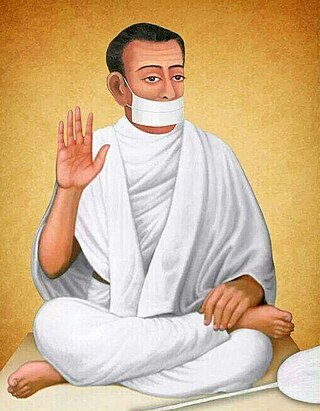
Acharya Bhikshu (1726–1803) was the founder and first spiritual head of the Śvetāmbara Terapanth sect of Jainism.
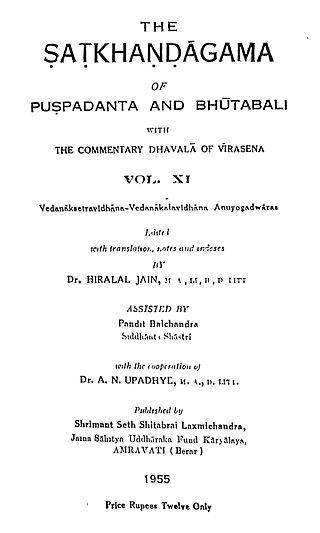
The Ṣaṭkhaṅḍāgama is the foremost and oldest Digambara Jain sacred text. According to Digambara tradition, the original teachings of lord Mahavira were passed on orally from Ganadhar, the chief disciple of Mahavira to his disciples and so on as they had the capability of listening and remembering it for always. But as the centuries passed there was downfall in these capabilities and so Ācārya Puṣpadanta and Bhūtabali penned down the teachings of Mahavira in Ṣaṭkhaṅḍāgama. Therefore the Ṣaṭkhaṅḍāgama is the most revered Digambara text that has been given the status of āgama.

Jainism is a religion founded in ancient India. Jains trace their history through twenty-four tirthankara and revere Rishabhanatha as the first tirthankara. The last two tirthankara, the 23rd tirthankara Parshvanatha and the 24th tirthankara Mahavira are considered historical figures. According to Jain texts, the 22nd tirthankara Neminatha lived about 84,000 years ago and was the cousin of Krishna.

Jain literature refers to the literature of the Jain religion. It is a vast and ancient literary tradition, which was initially transmitted orally. The oldest surviving material is contained in the canonical Jain Agamas, which are written in Ardhamagadhi, a Prakrit language. Various commentaries were written on these canonical texts by later Jain monks. Later works were also written in other languages, like Sanskrit and Maharashtri Prakrit.
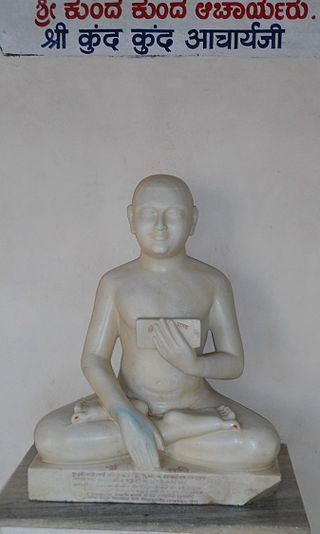
Digambara is one of the two major schools of Jainism, the other being Śvetāmbara (white-clad). The Sanskrit word Digambara means "sky-clad", referring to their traditional monastic practice of neither possessing nor wearing any clothes.

Jainism is an Indian religion which is traditionally believed to be propagated by twenty-four spiritual teachers known as tirthankara. Broadly, Jainism is divided into two major schools of thought, Digambara and Śvetāmbara. These are further divided into different sub-sects and traditions. While there are differences in practices, the core philosophy and main principles of each sect is the same.

Akalanka was a Jain logician whose Sanskrit-language works are seen as landmarks in Indian logic. He lived from 720 to 780 A.D. and belonged to the Digambara sect of Jainism. His work Astasati, a commentary on Aptamimamsa of Acharya Samantabhadra deals mainly with jaina logic. He was a contemporary of Rashtrakuta king Krishna I. He is the author of Tattvārtharājavārtika, a commentary on major Jain text Tattvartha Sutra. He greatly contributed to the development of the philosophy of Anekantavada and is therefore called the "Master of Jain logic".
Prabhācandra was a Śvetāmbara monk, grammarian, biographer, philosopher and author of several philosophical books on Jainism.
Jain festivals occur on designated days of the year. Jain festivals are either related to life events of Tirthankara or they are performed with intention of purification of soul.

Pravacanasāra is a text composed by Jain monk Kundakunda in the second century CE or later. The title means "Essence of the Doctrine" or "Essence of the Scripture", and it largely deals with the correct ascetic and spiritual behavior based on his dualism premise. Kundakunda provides a rationale for nudity among Digambara monks in this text, stating that the duality of self and of others means "neither I belong to others, nor others belong to me, therefore nothing is mine and the ideal way for a monk to live is the way he was born". The text is written in Prakrit language, and it consists of three chapters and 275 verses.
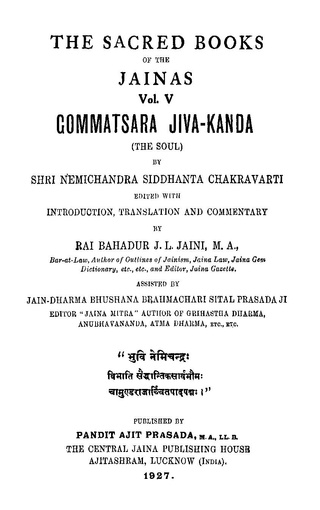
Gommatsāra is one of the most important Jain texts authored by Acharya Nemichandra Siddhanta Chakravarti.

Acharya Bhutabali was a Digambara monk. He along with Acharya Pushpadanta composed the most sacred Jain text, Satkhandagama..
AcharyaDharasena was a Digambara monk of first century CE.
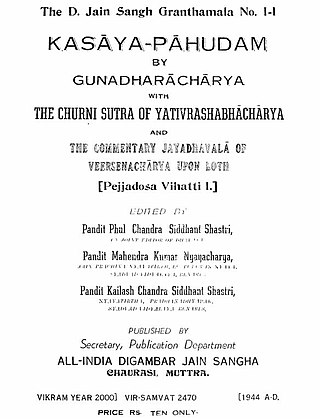
Kasayapahuda is one of the oldest canonical text of the Digambara Jains. Another oldest canonical text, the Shatkhandagama was written about the same time. Both these texts are held in high esteem by the Digambaras. Kasaya (passions) form the subject matter of Kasayapahuda.
















